Input interpretation

ethylene glycol
Chemical names and formulas

formula | HOCH_2CH_2OH Hill formula | C_2H_6O_2 name | ethylene glycol alternate names | 1, 2-dihydroxyethane | 1, 2-ethanediol | ethane-1, 2-diol | ethylene alcohol | fridex | glycol | glycol alcohol | monoethylene glycol | norkool | tescol mass fractions | C (carbon) 38.7% | H (hydrogen) 9.74% | O (oxygen) 51.6%
Lewis structure
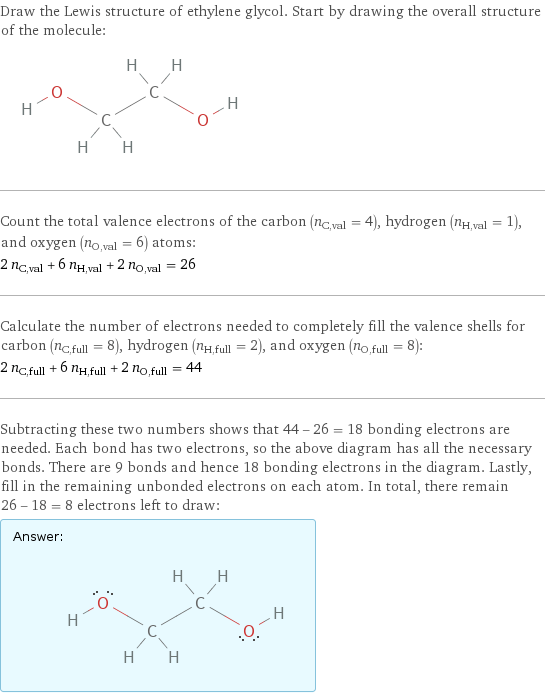
Draw the Lewis structure of ethylene glycol. Start by drawing the overall structure of the molecule: Count the total valence electrons of the carbon (n_C, val = 4), hydrogen (n_H, val = 1), and oxygen (n_O, val = 6) atoms: 2 n_C, val + 6 n_H, val + 2 n_O, val = 26 Calculate the number of electrons needed to completely fill the valence shells for carbon (n_C, full = 8), hydrogen (n_H, full = 2), and oxygen (n_O, full = 8): 2 n_C, full + 6 n_H, full + 2 n_O, full = 44 Subtracting these two numbers shows that 44 - 26 = 18 bonding electrons are needed. Each bond has two electrons, so the above diagram has all the necessary bonds. There are 9 bonds and hence 18 bonding electrons in the diagram. Lastly, fill in the remaining unbonded electrons on each atom. In total, there remain 26 - 18 = 8 electrons left to draw: Answer: | |
3D structure
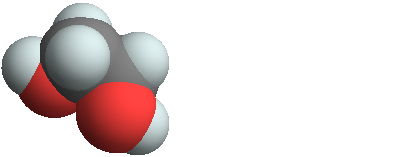
3D structure
Basic properties
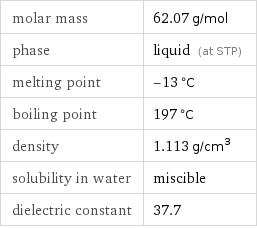
molar mass | 62.07 g/mol phase | liquid (at STP) melting point | -13 °C boiling point | 197 °C density | 1.113 g/cm^3 solubility in water | miscible dielectric constant | 37.7
Hydrophobicity and permeability properties

experimental LogP hydrophobicity | -1.36 predicted LogP hydrophobicity | -1.52 predicted LogS | 1.18
Basic drug properties

approval status | experimental | small molecule
Liquid properties (at STP)
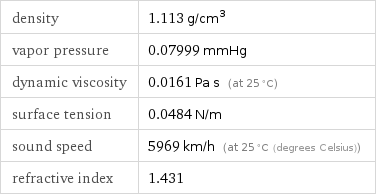
density | 1.113 g/cm^3 vapor pressure | 0.07999 mmHg dynamic viscosity | 0.0161 Pa s (at 25 °C) surface tension | 0.0484 N/m sound speed | 5969 km/h (at 25 °C (degrees Celsius)) refractive index | 1.431
Units
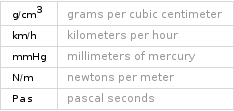
Thermodynamic properties
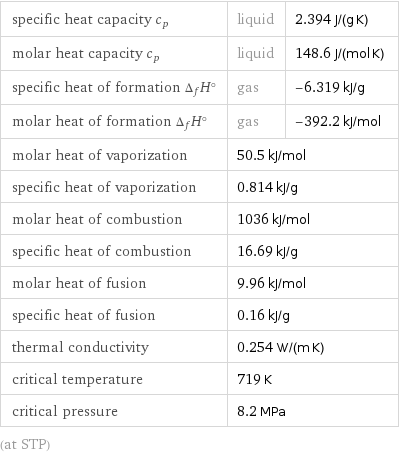
specific heat capacity c_p | liquid | 2.394 J/(g K) molar heat capacity c_p | liquid | 148.6 J/(mol K) specific heat of formation Δ_fH° | gas | -6.319 kJ/g molar heat of formation Δ_fH° | gas | -392.2 kJ/mol molar heat of vaporization | 50.5 kJ/mol | specific heat of vaporization | 0.814 kJ/g | molar heat of combustion | 1036 kJ/mol | specific heat of combustion | 16.69 kJ/g | molar heat of fusion | 9.96 kJ/mol | specific heat of fusion | 0.16 kJ/g | thermal conductivity | 0.254 W/(m K) | critical temperature | 719 K | critical pressure | 8.2 MPa | (at STP)
Chemical identifiers
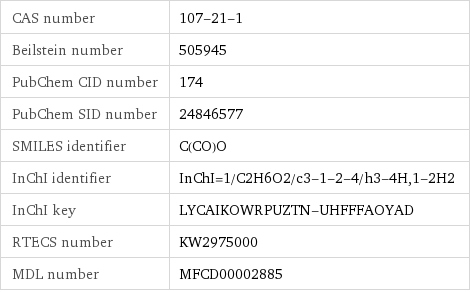
CAS number | 107-21-1 Beilstein number | 505945 PubChem CID number | 174 PubChem SID number | 24846577 SMILES identifier | C(CO)O InChI identifier | InChI=1/C2H6O2/c3-1-2-4/h3-4H, 1-2H2 InChI key | LYCAIKOWRPUZTN-UHFFFAOYAD RTECS number | KW2975000 MDL number | MFCD00002885
NFPA label

NFPA label

NFPA health rating | 1 NFPA fire rating | 1 NFPA reactivity rating | 0
Safety properties

flash point | 110 °C autoignition point | 398 °C lower explosive limit | 3.2% (concentration in air) upper explosive limit | 15.3% (concentration in air)
Toxicity properties

threshold limit value | 40 ppmv

RTECS classes | agricultural chemical and pesticide | tumorigen | mutagen | reproductive effector | human data | primary irritant